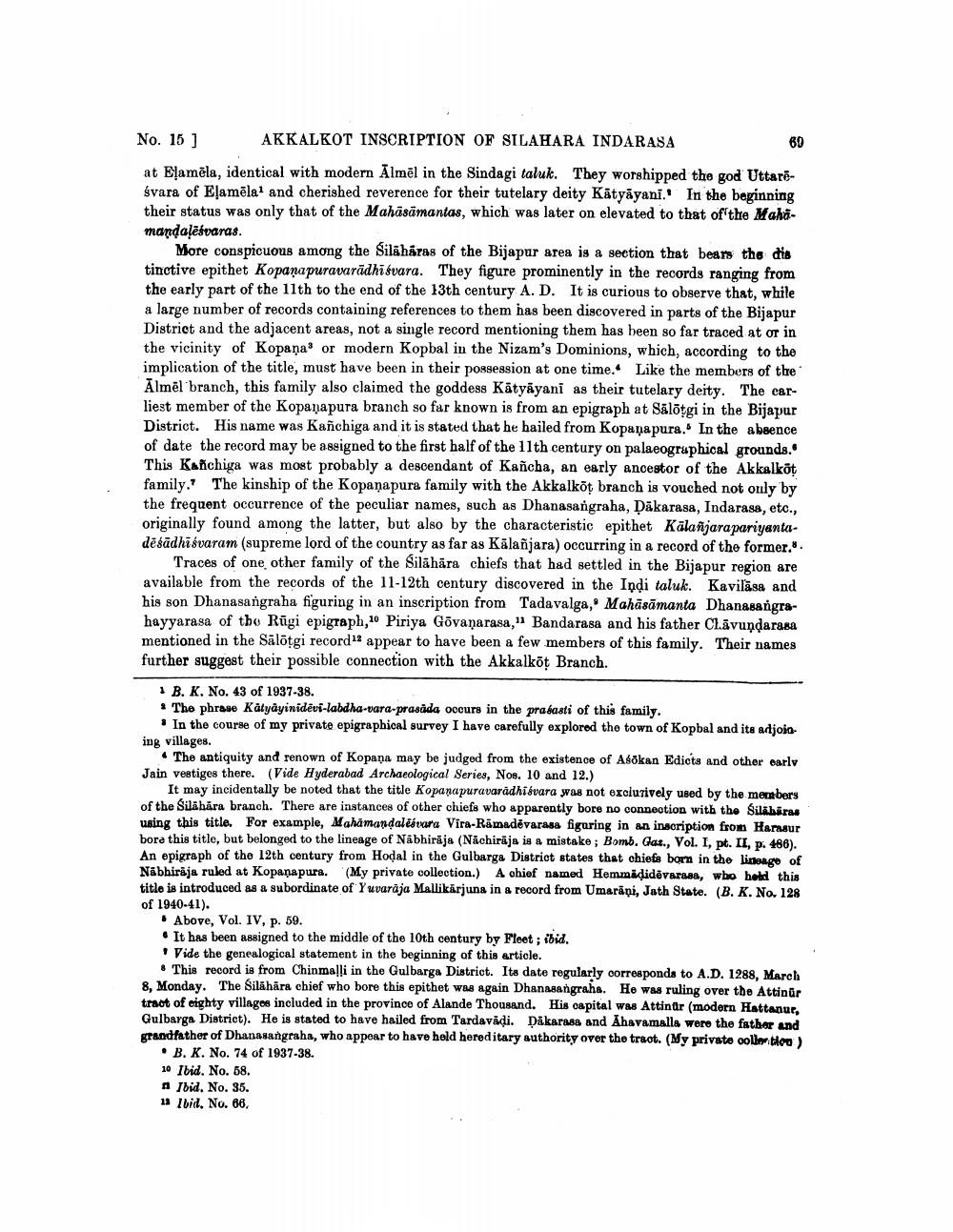________________
No. 15 ]
AKKALKOT INSCRIPTION OF SILAHARA INDARASA
at Elamela, identical with modern Almel in the Sindagi taluk. They worshipped the god Uttareśvara of Elamēla1 and cherished reverence for their tutelary deity Katyayani. In the beginning their status was only that of the Mahāsāmantas, which was later on elevated to that of the Mahamandaķētvaras.
More conspicuous among the Silahāras of the Bijapur area is a section that bears the dis tinctive epithet Kopanapuravaradhisvara. They figure prominently in the records ranging from the early part of the 11th to the end of the 13th century A. D. It is curious to observe that, while a large number of records containing references to them has been discovered in parts of the Bijapur District and the adjacent areas, not a single record mentioning them has been so far traced at or in the vicinity of Kopana or modern Kopbal in the Nizam's Dominions, which, according to the implication of the title, must have been in their possession at one time. Like the members of the Almel branch, this family also claimed the goddess Katyayani as their tutelary deity. The earliest member of the Kopanapura branch so far known is from an epigraph at Sälōṭgi in the Bijapur District. His name was Kañchiga and it is stated that he hailed from Kopanapura. In the absence of date the record may be assigned to the first half of the 11th century on palaeographical grounds. This Kanchiga was most probably a descendant of Kañcha, an early ancestor of the Akkalkot family. The kinship of the Kopanapura family with the Akkalkot branch is vouched not only by the frequent occurrence of the peculiar names, such as Dhanasangraha, Dakarasa, Indarasa, etc., originally found among the latter, but also by the characteristic epithet Kalañjarapariyantadēsādhisvaram (supreme lord of the country as far as Kalañjara) occurring in a record of the former.". Traces of one other family of the Silähära chiefs that had settled in the Bijapur region are available from the records of the 11-12th century discovered in the Indi taluk. Kavilăsa and his son Dhanasangraha figuring in an inscription from Tadavalga, Mahāsāmanta Dhanasangrahayyarasa of the Rugi epigraph, 10 Piriya Gōvanarasa," Bandarasa and his father Chavundarasa mentioned in the Salōtgi record appear to have been a few members of this family. Their names further suggest their possible connection with the Akkalkot Branch.
60
1 B. K. No. 43 of 1937-38.
The phrase Kalyāyinidēvi-labdha-vara-prasada occurs in the prasasti of this family.
In the course of my private epigraphical survey I have carefully explored the town of Kopbal and its adjoin ing villages.
The antiquity and renown of Kopana may be judged from the existence of Asokan Edicts and other early Jain vestiges there. (Vide Hyderabad Archaeological Series, Nos. 10 and 12.)
It may incidentally be noted that the title Kopanapuravaradhisvara was not excluzively used by the members of the Silähära branch. There are instances of other chiefs who apparently bore no connection with the Silähäras using this title. For example, Mahamandaleévara Vira-Ramadevarasa figuring in an inscription from Harasur bore this title, but belonged to the lineage of Nabhiraja (Nächiraja is a mistake; Bomb. Gaz., Vol. I, pt. II, p. 486). An epigraph of the 12th century from Hodal in the Gulbarga District states that chiefs born in the lineage of Nabhiraja ruled at Kopanapura. (My private collection.) A chief named Hemmäḍidëvarasa, who held this title is introduced as a subordinate of Yuvaraja Mallikarjuna in a record from Umarāni, Jath State. (B. K. No. 128 of 1940-41).
Above, Vol. IV, p. 59.
It has been assigned to the middle of the 10th century by Fleet; ibid.
Vide the genealogical statement in the beginning of this article.
This record is from Chinmalli in the Gulbarga District. Its date regularly corresponds to A.D. 1288, March 8, Monday. The Silāhāra chief who bore this epithet was again Dhanasangraha. He was ruling over the Attinür tract of eighty villages included in the province of Alande Thousand. His capital was Attinür (modern Hattanur, Gulbarga District). He is stated to have hailed from Tardavādi. Däkarasa and Ahavamalla were the father and grandfather of Dhanasangraha, who appear to have held hereditary authority over the tract. (My private collection)
B. K. No. 74 of 1937-38.
10 Ibid. No. 58.
Ibid. No. 35.
12 Ibid. No. 66,




